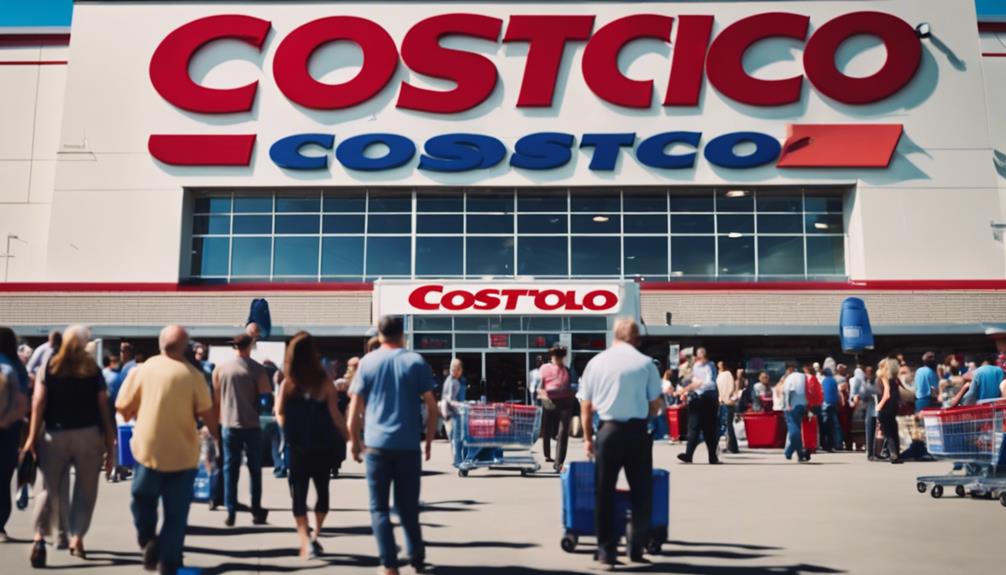Costco's new photo ID requirement at checkout aims to tighten membership sharing restrictions. This move targets self-checkout lanes to prevent unauthorized access for nonmembers. By enforcing this policy, Costco seeks to maintain its competitive pricing and guarantee that the benefits of membership, like bulk discounts, aren't exploited. This approach mirrors trends in other industries that are limiting access to paying members only. Overall, the photo ID initiative reflects Costco's commitment to strengthening its membership model and may signal shifts in how memberships are valued in the future. There's much more to uncover about these changes and their implications.
Key Takeaways
- Costco has implemented a new photo ID requirement at checkout to enforce membership rules and prevent unauthorized access at self-checkout lanes.
- This policy aims to maintain the integrity of the membership model and deter potential abusers from sharing their memberships.
- The enforcement of photo ID checks is part of a broader trend among companies to tighten restrictions on membership sharing and enhance exclusivity.
- Membership fees, including $60 for Gold Star and $120 for Executive, are crucial for sustaining low prices and operational costs.
Membership Sharing Enforcement
Costco's new photo ID requirement at checkout is a direct response to rampant membership sharing, aiming to guarantee that only paying members access exclusive benefits. Furthermore, the photo ID requirement also helps to ensure that members are able to take advantage of Costco’s efficient and personalized customer service. By cracking down on membership sharing, Costco is able to uphold the integrity of its membership program and maintain the quality of its offerings. In a similar effort to protect the integrity of their brand and offerings, zinepak’s shark tank journey allowed them to secure the necessary funding and guidance to take their business to the next level.
This policy specifically targets self-checkout lanes, where unauthorized users often exploit the system.
By enforcing this measure, Costco asserts that nonmembers shouldn't be allowed to enjoy the perks that come with membership, such as low prices on bulk items.
Membership sharing not only undermines the integrity of their membership model but also threatens the company's ability to maintain competitive pricing.
As Costco implements this crackdown, it hopes to deter potential abusers and reinforce the value of being a paying member, ultimately ensuring that its exclusive benefits remain intact for those who contribute to the company's revenue.
Understanding Membership Fees

Understanding the structure of membership fees is essential for appreciating the value that Costco provides to its members. The membership options cater to different needs, ensuring everyone finds a suitable plan.
| Membership Type | Annual Fee |
|---|---|
| Gold Star Membership | $60 |
| Executive Membership | $120 |
| Business Membership | $60 each additional member |
Gold Star membership costs $60 annually, while Executive membership, offering additional rewards, is priced at $120. For businesses, each additional member under a Business membership also incurs a $60 fee. These fees help offset operational expenses, which is vital for maintaining Costco's low prices and ensuring members receive maximum value for their investment.
Comparisons With Other Industries

Many companies across various industries are tightening restrictions on membership sharing to protect their revenue streams.
For instance, Netflix recently implemented a policy that charges a $7.99 fee for additional accounts outside a household. This move attracted over 100,000 new subscribers shortly after the change.
Similarly, gyms and streaming services are increasingly focusing on limiting access to paying members only. These industries recognize that unrestricted sharing undermines their business models and revenue potential.
As more companies adopt stricter policies, the trend toward enhanced member exclusivity is becoming evident.
Future of Costco Memberships

The recent photo ID requirement at Costco could greatly alter the dynamics of future memberships as the company seeks to tighten control over member access. This move might lead to changes in how individuals perceive the value of their memberships, potentially impacting sign-ups.
| Membership Type | Current Fee | Future Considerations |
|---|---|---|
| Gold Star Membership | $60 | Increased verification needed |
| Executive Membership | $120 | Possible fee adjustments |
| Business Membership | $60/additional | Stricter enforcement anticipated |
| Family Cardholder | N/A | Potential limits on sharing |
As the policy evolves, Costco may enhance its member verification processes, establishing a new norm that could redefine the membership landscape in retail.
Implications for Business Sustainability

Costco's photo ID requirement underscores the importance of membership fees in sustaining its business model, as these fees directly contribute to maintaining low prices for consumers. By enforcing stricter membership policies, Costco aims to bolster its revenue streams while ensuring that only paying members access its benefits.
This approach has several implications for business sustainability:
- Enhanced Revenue Protection: Reducing membership sharing preserves the integrity of membership fees.
- Customer Loyalty: Stricter policies may reinforce the value of membership, fostering a stronger sense of community among members.
- Operational Cost Management: Increased revenue from memberships enables Costco to continue offering low prices on goods.
These strategies reflect Costco's commitment to long-term sustainability in a competitive retail environment.
Conclusion
Costco's photo ID requirement marks a significant step in enforcing membership integrity, echoing similar moves by other companies like Netflix.
By tightening controls, Costco aims to preserve its low-cost model, ensuring that only paying members benefit from its offerings.
As consumers adapt, the future of Costco memberships may hinge on this balance between access and exclusivity.
If successful, this strategy could strengthen customer loyalty, much like how airlines have enhanced their loyalty programs to retain frequent flyers.









